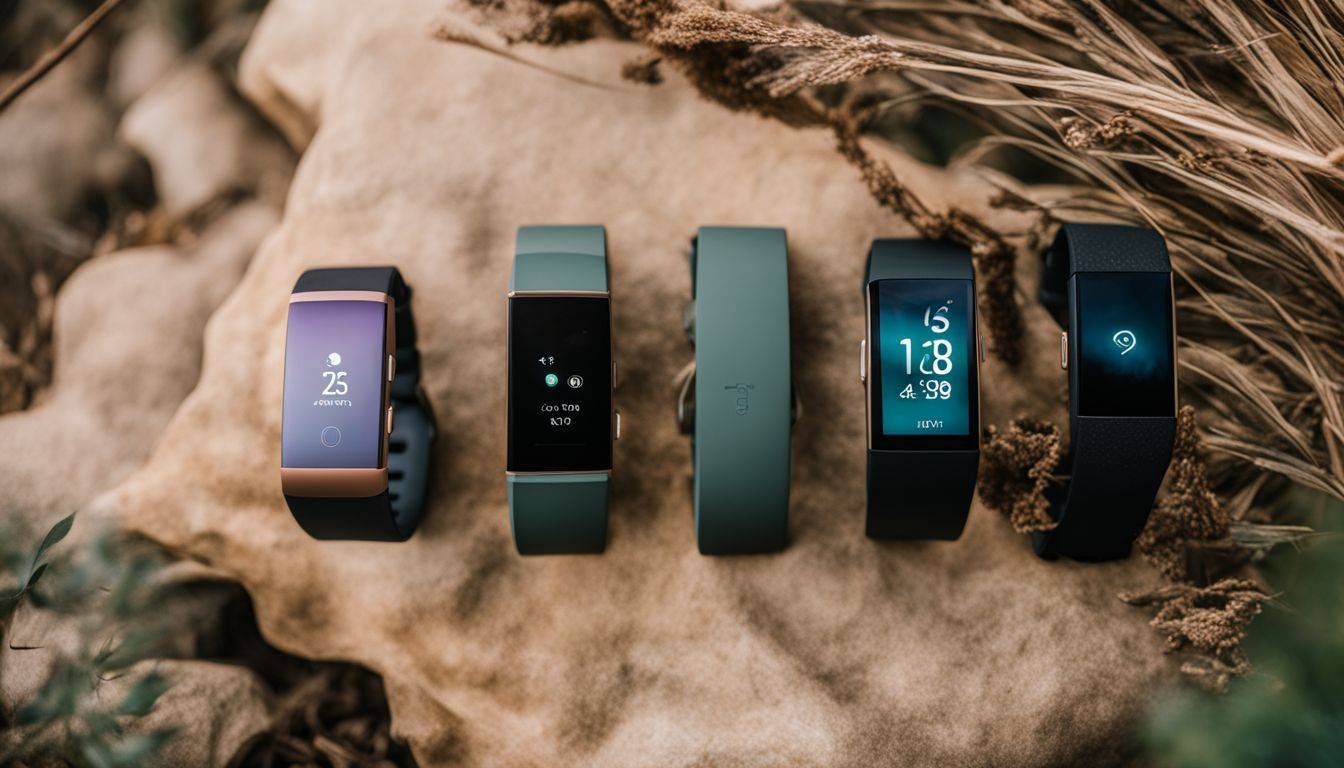Finding the right fitness tracker can be as tricky as the last few pounds of a weight-loss journey. The Fitbit Charge 4 is not just another wristband; it’s a comprehensive tool designed for those serious about tracking their health and fitness.
This review will guide you through its features, performance, and how it stacks up against other popular trackers to address all your workout needs. Keep reading – your fitness companion awaits!
Overview of Fitbit Charge 4 Features

Delving into the core capabilities of the Fitbit Charge 4, this section unpacks a robust suite of features designed to elevate your fitness journey. From precise location tracking with built-in GPS to comprehensive heart rate and sleep monitoring, discover how this wearable tech aims to support your wellness goals seamlessly.
Built-in GPS and Heart Rate Monitor
The Fitbit Charge 4 comes with GPS built right in. This means you can track your run or bike ride without needing your phone. You’ll see your pace and distance, and after the workout, a map of your route.
The heart rate monitor works all day and night to keep an eye on how hard your heart is working. It tells you when you’re burning fat, cardio-level effort or peaking. This helps make sure you get the most out of every exercise session.
Activity tracking is easy with the Charge 4’s Active Zone Minutes feature. It shows how much time you spend in each heart rate zone during workouts. Aim for 150 minutes a week to stay healthy! Plus, it has a special map that shows where and how intense the workout was based on your heart rate zones.
Activity Tracking and Sleep & Swim Tracking
Fitbit Charge 4 keeps you moving with its all-day activity tracking. It counts steps, monitors heart rate, and recognizes different workouts like running or biking automatically. You’ll see your stats right on your wrist and know when to push harder or take a day to recover.
Sleep is crucial for fitness, and the Charge 4 has got this covered too. It tracks sleep stages—including REM—and gives you a Sleep Score in the app. This score helps you understand your sleep quality each night.
Plus, there’s no need to take it off before diving into the pool; it’s swimproof up to 50 meters! Whether swimming laps or taking a shower, this tracker handles it all without missing a beat—or step!
Battery Life and Connectivity
The Charge 4 keeps you moving with a battery that lasts up to 7 days. If you’re using the GPS, expect about 5 hours of power. You won’t be charging it every night, so it’s ready whenever you are.
Syncing your stats is easy too. With Bluetooth LE and internet, connect to phones and computers quickly. It pairs with many devices – from iPhones (5S and later) to Android phones (7.0+) and even iPads.
This tracker needs just one tap to hook up with your smartphone via Bluetooth, keeping all your data in sync. Whether you’re on a Mac or an iPhone, this fitness buddy has got your back.
Now let’s dive into how the Fitbit Charge 4 performs day-to-day.
Detailed Review of Performance and User Experience

People love the Fitbit Charge 4 for its accurate GPS and heart rate monitor. You can go for a run and track your route, pace, and distance without your phone. It tells you how hard you’re working out with Active Zone Minutes.
This feature looks at your heart rate zones and helps you hit that 150-minute weekly exercise goal.
Users say the sleep tracking is spot on, too. At night, it measures how well you slept by giving you a Sleep Score. Plus, this tracker won’t die on you quickly; it lasts up to 7 days or 5 hours if the GPS is on non-stop.
And buying things is easy—just swipe your wrist using Fitbit Pay! Now let’s see how Fitbit Charge 4 stands next to other fitness trackers.
Comparison with Other Fitness Trackers
Discover how the Fitbit Charge 4 stacks up against its family members and rivals in the fitness tracker arena, shedding light on key differences that could sway your decision—dive in to find which wearable meets your wellness goals and lifestyle needs.
fitbit charge 4 vs charge 5
When it comes to choosing between the Fitbit Charge 4 and its successor, the Fitbit Charge 5, fitness enthusiasts are presented with a tough decision. Each device offers unique features that cater to different needs and preferences. Let’s break down the differences using a comparative approach.
| Feature | Fitbit Charge 4 | Fitbit Charge 5 |
|---|---|---|
| Built-in GPS | Yes | No (Connected GPS) |
| Display Type | Grayscale OLED | Color AMOLED |
| Health Monitoring | Heart Rate Monitor | Heart Rate Monitor, EDA Sensor for Stress, ECG App |
| Battery Life | Up to 7 days | Longer battery life than Charge 4 |
| Additional Sensors | None | Skin Temperature Tracking |
| Fitness & Activity Tracking | Comprehensive | Comprehensive with Advanced Features |
| Color Options | Black/Black | Variety of Colors |
Both devices will serve you well, with the Charge 5 taking a slight edge in terms of advanced health features and display quality. Your personal requirements and budget will largely influence the final choice. The Fitbit Charge 4 stands its ground with reliable tracking and its own GPS, while the Charge 5 advances with a more modern look and extra health sensors. Each variant holds its merit, making the selection a personalized decision for any fitness enthusiast.
fitbit charge 4 vs inspire 3
The Fitbit Charge 4 and Fitbit Inspire 3 cater to fitness enthusiasts who desire varied levels of activity tracking. Let’s delve into a comparison of these two models to illuminate their differences.
| Feature | Fitbit Charge 4 | Inspire 3 |
|---|---|---|
| Built-in GPS | Yes | No |
| Heart Rate Zones | Personalized | Standard |
| Workout Intensity Map | Available | Not Available |
| Spotify Control | Yes | No |
| Active Zone Minutes | Yes | No |
| Battery Life | Up to 7 days | Less than Charge 4 |
| Water Resistance | 50m | Not Specified |
| Fitbit Pay | Yes | No |
| Overall Fitness Tracking Experience | More Premium | Basic |
The Charge 4’s GPS capability paves the way for detailed route tracking. Music aficionados will appreciate the Spotify control feature. With a robust battery life, the Charge 4 stands out. Its Active Zone Minutes encourage users to intensify workouts. Fitbit Pay adds a layer of convenience. Those who prefer a comprehensive fitness tracker will find the Charge 4 an attractive option. Contrastingly, the Inspire 3 offers a more streamlined, though less feature-rich, tracking experience, suitable for users with simpler needs.
Fitbit Charge 4 vs Charge 3
Moving on from the comparison with the Inspire 3, let’s delve into the differences between the Fitbit Charge 4 and its predecessor, the Charge 3. These two models share a lineage but differ significantly in functionality and features that cater to fitness enthusiasts.
| Feature | Fitbit Charge 4 | Fitbit Charge 3 |
|---|---|---|
| Built-in GPS | Yes | No |
| Heart Rate Zones | Personalized Zones | Standard Zones |
| Active Zone Minutes | Yes | No |
| Spotify Control | Yes | No |
| Battery Life | Up to 7 days | Shorter than Charge 4 |
| Fitbit Pay | Yes | No |
Advancements in the Charge 4, such as the built-in GPS and Active Zone Minutes, offer users a more comprehensive fitness tracking experience. With Spotify control and the convenience of Fitbit Pay, the Charge 4 emerges as the more versatile option for those seeking an all-in-one fitness tracker.
Fitbit Charge 4 vs Versa 2
The Fitbit Charge 4 stands out with its built-in GPS, letting you see your pace and distance on screen during outdoor runs and rides. Versa 2, however, relies on your phone for GPS. Charge 4 also steps up the game with Active Zone Minutes. This feature buzzes your wrist when you reach your personalized target heart rate zones. The Versa 2 misses out on this.
Versa 2 might have its advantages with a larger display and Amazon Alexa built in, but it falls short compared to Charge 4’s water resistance of up to 50 meters—making it a better buddy for swimmers. Plus, the battery life on the Charge 4 keeps you going longer; enjoy up to seven days without needing a charge compared to Versa’s shorter span. With both trackers offering round-the-clock heart rate tracking and sleep monitoring features, choosing between them depends heavily on whether you prefer an emphasis on fitness or smartwatch features.
Fitbit Charge 4 vs Versa 3
Fitbit Charge 4 comes with built-in GPS, a game-changer for runners and bikers who want to leave their phone at home. Versa 3 lacks this feature, meaning you’ll need your phone close by to map your routes. Heart rate monitoring is top-notch on both devices, offering personalized zones for effective workout tracking. However, Charge 4 takes it up a notch with its workout intensity map that shows exactly where you put in the most effort – something Versa 3 users won’t get.
Both trackers watch over your heart trends and resting rate, but if swimming is your go-to sport, Charge 4’s water-resistance up to 50 meters makes it more reliable in the pool than Versa 3. While Charge 4 focuses on premium fitness tracking, Versa 3 leans into its smartwatch features for those wanting more versatility on their wrist.
Conclusion
In sum, the Fitbit Charge 4 packs a punch with top-notch features like built-in GPS and robust heart rate monitoring. It’s perfect for tracking your workouts and swimming laps. Users get a detailed view of their fitness journey, from pace to sleep quality.
If you’re into keeping tabs on your health metrics, this gadget is worth considering. Now step up your fitness game with confidence!
